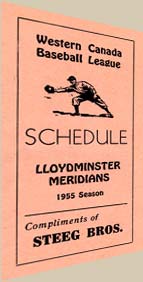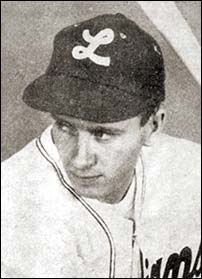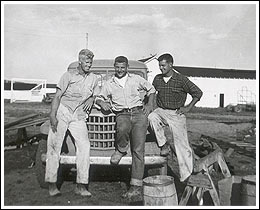
Lloydminster overcame the doom and gloom from the 1954 season and charged ahead with an entry in the revised loop for 1955.
Edmonton and Regina were in, Indian Head and Rosetown out, and the loop became the Western Canada Independent Baseball League.
There was an added incentive this season. The league champions would represent Canada at the inaugural Global World Series in Milwaukee.
The Edmonton Eskimos would win the league championship with a thrilling 5-1, 13 inning victory over the Saskatoon Gems in the deciding game of the best-of-seven final.
The Eskimos, however, didn't make the trip to Milwaukee. Apparently, the Eskimos didn't want to go along with an agreement to add other players to the roster. Thus, the league decided upon a combined entry, with Saskatoon Gems as the core.
The Gems finished third in the global event. However, Cliff Pemberton walked away with the trophy as the best hitter of the tournament. Pemberton also won the batting crown during the regular season.
The Meridians would again finish last -- with a worse record than in their debut season of 1954.
 There was considerable turnover at the top.
There was considerable turnover at the top.
Only one of the managers from '54 was back at the helm -- Ralph Mabee of Saskatoon.
The Meridians brought in local star Don Stewart (left).
The North Battleford Beavers went with Ken Nelson, Moose Jaw turned to Roy Taylor, Regina brought in Pete Beiden, and the Esimos from Edmonton had Jim Ryan (who took over after Roy Carlson left for a teaching job in Germany).

 Southpaw Charlie Bogan (left) of Saskatoon was the league's top winner with 12 wins.
Southpaw Charlie Bogan (left) of Saskatoon was the league's top winner with 12 wins.
Edmonton righthander Dale Bloom (right) captured the ERA title with a mark of 1.72. Bogan was third at 2.38.





Saskatoon 3B Cliff Pemberton (left), in his first full season in the league, won the batting title with a .360 average. It would be Pemberton's first of three Western Canada batting championships.
Jim Shirley (2nd from left) the Saskatoon catcher finished second at .337 and Edmonton outfielder Cal Bauer (3rd from left) was third with a .336 average. Bauer led the league in homers with 10. Mario Herrera (right) of Saskatoon was tops in stolen bases with 30.
 Barney Brown said he was 42, but the records indicate he was really 47. Still, the long time star of the Negro Leagues had an incredible season. According to the official statistics he made 10 starts for the Meridians -- all complete games.
Barney Brown said he was 42, but the records indicate he was really 47. Still, the long time star of the Negro Leagues had an incredible season. According to the official statistics he made 10 starts for the Meridians -- all complete games.
Brown finished with an ERA of 2.90, fifth best in the league. However, the officials stats are incomplete. One game not registered was a season-ending 11 inning, 12 strikeout performance in a game that ended in a 2-2 tie. So, 11 starts, 11 complete games, an ERA under 3.00. Not bad for a slim lefty just shy of 50. And, he'd return for another season. (Photo courtesy Chuck McGuigan)
There were some pretty good teenagers too.
18-year-old Charlie Bogan led the league with twelve wins. Ted Ellis won nine and finished with an ERA of 2.50.
 The season also featured Kirby Pain's (left) no-hitter and Pain's scoreless streak of 30 2/3s innings.
The season also featured Kirby Pain's (left) no-hitter and Pain's scoreless streak of 30 2/3s innings.
Edmonton pulled off a triple play. Art Worth hit for the cycle. Saskatoon's Cliff Pemberton and Regina's owner, Denny Evenson got into a punch up during a game.
North Battleford played games in two different cities the same day, and lost both. The Gems won 14 in a row. Lloydminster and Regina hooked up in a contest which produced 24 hits, 24 walks, 9 errors and 28 runs.
Superstitious? Not Saskatoon. In early July, Gems punched out 13 hits for 13 runs to beat Lloydminster for their 13th straight win, 13-7.
A pitcher's best friend. Meridians' catcher Dick Barry picked off six baserunners during a double-header at Lloydminster.
Lou Hague of Moose Jaw had eleven straight hits.
And, the losing team got to represent Canada at the Global World Series.
The Meridians traded their best pitcher for a hitter. In fact, the club ended up moving both Max Weekly and Darrell Martin to Moose Jaw in a deal which brought Collins Jones, Bill Duft and Kirby Wyllie to Lloydminster.
Ironically, Weekly and Martin finished with a higher, combined batting average than Jones (.300 to .285) . On the hill, the California hurlers each won seven games.
At the end of the season it was reported that Weekly had signed a contract with the New York Yankees and was to report to Quincy of the Class B, Three-Eye League.
 Outfielder Denny Cochrane (left) of the Regina Red Sox became the new batting king of the Southern League, edging out Assiniboia Aces' versatile Gord Skjerven by a marginal .006 percentage points in winning the 1955 title with a .398 average. Cochrane also led or tied for the lead in 4 of the 5 offensive categories. The Crimson Hose fly-chaser cracked out the most hits, 35, scored the greatest number of runs, 31, and tied for the lead in doubles and triples.
Outfielder Denny Cochrane (left) of the Regina Red Sox became the new batting king of the Southern League, edging out Assiniboia Aces' versatile Gord Skjerven by a marginal .006 percentage points in winning the 1955 title with a .398 average. Cochrane also led or tied for the lead in 4 of the 5 offensive categories. The Crimson Hose fly-chaser cracked out the most hits, 35, scored the greatest number of runs, 31, and tied for the lead in doubles and triples.
Another Red Sox player, righthanded pitcher Tom Leverick, topped the league's hurlers in winning percentage with an unblemished 5 - 0 record.
The youthful Reginans won the regular season battle by a comfortable four and a half game margin and extended their dominance into the playoffs by knocking off the Notre Dame Hounds in straight games in a semi-final set and then coming back from a two games to none deficit to defeat the Weyburn Beavers to take the post-season spoils.


Some of the local kids did OK too. The paper may have had some trouble with the name, but Dick Doekper had no trouble with the hitters. A month after this one, he did it again. The Saskatchewan junior won a spot on the club at Roy Taylor's College of the Sequoias in Visalia, CA and later would suit up with Pete Beiden's Fresno State Bulldogs. (Saskatoon Star Phoenix, July 15, 1955 & August 16, 1955)
" ... Dick Doepker played for me [at COS] and was outstanding, one of our top pitchers. He went on to Fresno State and three years of pro ball. Then they didn't move young kids up. They didn't trust them and if they were college kids they hated them ... he came back to school ... became a principal of one of the biggest high schools in Visalia ... very, very outstanding … one of the top educators in the whole area". -- Roy Taylor, 2001

August 23rd, 1955. It was nearly over for the "hapless Meridians".
In spite of the headline, there was a final game to go and, while the Meridians didn't win the finale, they didn't lose either!
In a replay of 1954, Jack Altman and the Vulcan Elks won the pennant in the Foothills-Wheatbelt League only to be beaten by Granum in the playoffs. The White Sox went on to capture their second straight Alberta title downing Cold Lake in the provincial finals. Granum also won the Lacombe tournament and came second, to the Foothills-Wheatbelt All-Stars, in the Lethbridge Rotary tourney.
Greg Seastrom : "Jack called and had convinced them (Vulcan) to add another player. The worst part was he told them they needed a third pitcher and he let them know I could pitch. I was not a pitcher. I had pitched enough to know how to step on the mound and not to balk, but I certainly didn't have any ability at it. But, that didn't bother me at the time."
"We got room and we got two-hundred dollars a month, cash. Twice a month we would report to the bank and we would get a one-hundred dollar bill ... a full-course dinner was one-dollar."
"We would dress at home. The little ballparks didn't have facilities. It was not uncommon to see, at a dance after the game, ball players still in their uniforms out on the dance floor."
In the early years, there was an expectation that the "imports" would also have some "real" jobs in the community.
Jack Altman : "One of the jobs I had was lifting big, heavy boulders into a pickup truck. I did that a day or two and said I don't think I can pitch well if I keep doing this. So I didn't have to do it anymore ... Once, several of us had jobs driving tractors from Vulcan to Lethbridge."
Greg Seastrom : "I learned quite a lot about grain elevators as the manager of the elevator had a few jobs he didn't like to do.

John Pederson (left), Al Malarchuk (centre) and Willie Walasko (right) worked on the Wesley Ranch when not playing ball for Wesley's Granum White Sox.
"George had us painting the farm buildings, maintaining the ball park in town, hauling building materials for the hired carpenters that were adding new barns, cattle and hay sheds. I did this for two summers and went to school in the winters.
It was a good experience and it kept us fit and busy. We dressed like the workmen we were on the ranch and ate in the cookhouse with the cowboys." (Bill Walasko, February 2001. Photo courtsey of Bill Walasko)
 The ManDak League became an all-American circuit with the loss of Carman and Brandon. Bismarck and Dickinson were the new entries. Bismarck, which finished on top during the regular schedule, was upset in the final as Minot won the title in four straight games and took the championship for the fourth consecutive season.
The ManDak League became an all-American circuit with the loss of Carman and Brandon. Bismarck and Dickinson were the new entries. Bismarck, which finished on top during the regular schedule, was upset in the final as Minot won the title in four straight games and took the championship for the fourth consecutive season.
Roy Weatherly (right) of Williston punched out three hits on the final day of the regular season to win his second straight batting title with a .371 mark. He also led the league in homers, setting a ManDak record with 21.
Preston Elkins of Williston finished with a 7-0 mark and 2.34 ERA but was five innings short of qualifying for the ERA title. Minot's Sugar Cain claimed the honour with a 2.94 mark and had 92 strikeouts to lead the league for the second straight season.
Were they THAT obvious? The Minot Daily News of August 5, 1955 reported : " A crowd of 950 fans, plus 99 Canadian guests ... ".
Right-hander Mel Duncan, who joined Minot in mid-season, had quite a time in the Negro League before jumping to the ManDak loop. June 30th he fired a no-hitter for the Detroit Stars at Pine Bluff, Arkansas. Stars topped Memphis Red Sox 4-0 in a Negro American League contest. Later, Duncan would start for the East All-Stars in the 23rd annual East-West All-Star Classic. Satchel Paige was on the hill for the West.
